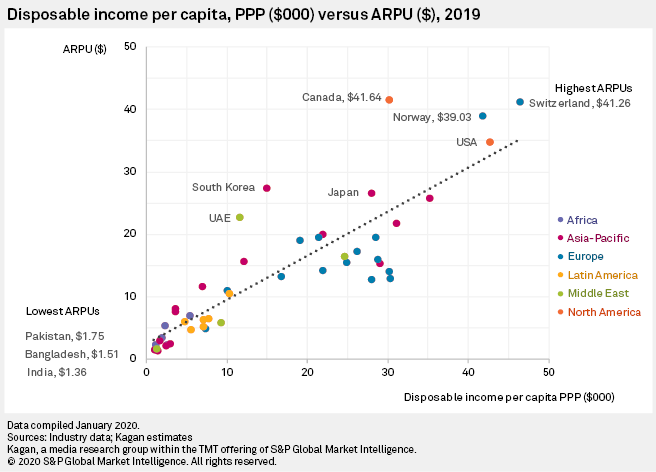Retail mobile and fixed network connectivity providers who sell directly to consumers arguably face some issues related to average revenue per account and cost per account. Whether in the mobile or fixed realms, mobile revenue per account seems to range from a few dollars a month up to $41 per month.

source: S&P Global Market Intelligence
Against that must be balanced the cost of infrastructure, operating and marketing costs plus all other overhead, ranging from personnel benefits to debt service and taxes. While not minor, network infrastructure costs are only part of the cost model.
Some have claimed 5G can reach break even in a five years or less. But that likely rests on excluding all other business costs except the network infrastructure. 5G capex per subscriber might range between $100 and $450 per year, during the network build period.
Even assuming a 20-percent profit margin, that still means 80 percent of revenue is consumed by operating costs, marketing, amortization of debt and other overhead, including personnel costs, retirement fund payments, dividend payments, taxes and so forth.
Looking at internet access prices using the purchasing power parity method, developed nation prices are around $35 to $40 a month. In absolute terms, developed nation prices are less than $30 a month.
That PPP normalization technique compares prices to gross national income per person. There are methodological issues when doing so, one can argue.
Gross national income is not household income, and per-capita measures might not always be the best way to compare prices, income or other metrics. But at a high level, measuring prices as a percentage of income provides some relative measure of affordability.
Generally speaking, broadband prices are dropping in developing countries, where the product is most expensive, and primarily because mobile internet access prices are dropping.

source: ITU
Looking at mobile voice and data prices, as a percentage of gross national income per person, one easily can see that very-high prices in lesser-developed countries skew global indices. In some developed markets, prices are less than one percent of GNI (without adjusting for purchasing power parity).

source: ITU
The unadjusted 2019 average price of a broadband internet access connection--globally--was $72..92, down $0.12 from 2017 levels, according to comparison site Cable. Other comparisons say the average global price for a fixed connection is $67 a month.
Looking at 95 countries globally with internet access speeds of at least 60 Mbps, U.S. prices were $62.74 a month, with the highest price being $100.42 in the United Arab Emirates and the lowest price being $4.88 in the Ukraine.
Another study by Deutsche Bank, looking at cities in a number of countries, with a modest 8 Mbps rate, found prices ranging between $50 to $52 a month.
The point is that network infrastructure investment now seems to hinge on revenue--depending on how we count it--that could range from a few dollars a month up to perhaps $72 a month.
Most of the market--with prices adjusted for currency and living standards--seems to be $40 a month or less.
That is challenging for fixed network operators deploying fiber to the home, if less a challenge for mobile operators, whose networks cost less, per customer or passing.
Among countries that are members of the Organization for Economic Cooperation and development, prices prices in 2016 seemed to cluster around $40 per month.
The take away is that FTTH payback--in many markets--cannot rest solely on home broadband revenues. Other revenue drivers likely must also contribute. Right now, that includes backhaul for 5G and future mobile networks, internet of things, edge computing, internet of things and applications that are owned by the connectivity providers.
Over time, those other sources might be even more important. Payback models of several decades ago assumed significant contributions from sources such as voice and video entertainment that have declined steadily.
The net change is a revenue-per-account ranging from $130 per month to $200 a month to the present $40 to $50 a month level. FTTH costs per passing have gotten better, but probably not enough to support revenue as low as $40 a month or even $50 a month.
Other value must be involved, or the payback model is not there.

